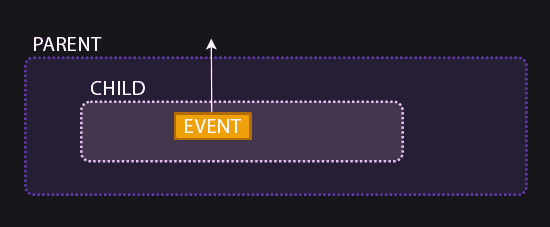In Vue.js, emit is a function that allows a child component to send a custom event to its parent component.

While props are the most common way to pass data from a parent component to a child, eventos are the most common way of communication in the reverse direction.
- ▲ Props: Allow for downward data flow (from parent to child)
- ▼ Events: Allow for upward data flow (from child to parent)
Additionally, the emitted event can carry associated data, enabling the parent to react and perform actions based on what happens in the child.
This design pattern allows for unidirectional data flow and is common in many modern frameworks, including Vue.js.
How to use emit
In Vue.js, we can declare the events that a component can emit in several ways. The most common is using the defineEmits() function:
<script setup>
// We define the events that this component can emit
const emit = defineEmits(['update', 'delete', 'select'])
// Now we can use the emit function in our component
function handleClick() {
emit('update', { id: 1, value: 'new value' })
}
</script>- defineEmits: This is a function that allows us to declare the events that the component can emit.
- emit: This is a function that takes two arguments:
- The name of the event (as a string)
- The data we want to send to the parent component (optional)
The defineEmits function returns an emit function configured with the events we want, which we can then use in our code.
Example of emit
Let’s better understand by doing a simple example.
- We create a child component that emits an event when a button is clicked.
- The parent component will listen for this event and display a message in the console.
<template>
<button @click="handleClick">Click me</button>
</template>
<script setup>
const emit = defineEmits(['button-clicked']);
const handleClick = () => {
emit('button-clicked', { message: 'The button was clicked' });
};
</script>handleClick: This is a function that runs when the user clicks the button.emit('button-clicked', { message: '...' }): Emits an event calledbutton-clickedwith an object containing a message.
<template>
<div>
<ChildComponent @button-clicked="handleClick" />
</div>
</template>
<script setup>
import ChildComponent from './ChildComponent.vue';
const handleClick = (data) => {
console.log('Event received:', data.message);
};
</script>@button-clicked="handleClick": Listens for thebutton-clickedevent emitted by the child component and runs thehandleClickfunction.handleClick: Receives the data sent by the child and logs it to the console.
Event validation with defineEmits
We can also use a more detailed syntax to validate the data types that are emitted:
<!-- ChildComponent.vue -->
<template>
<button @click="handleClick">Click me</button>
</template>
<script setup>
const emit = defineEmits({
// Validate that the 'button-clicked' event receives an object with a message
'button-clicked': (payload) => {
return payload.message && typeof payload.message === 'string';
},
});
const handleClick = () => {
emit('button-clicked', { message: 'The button was clicked' });
};
</script>defineEmits: Defines and validates the events that the component can emit.- Validation: Ensures that the event payload meets certain conditions.
Two-way communication with v-model and emit
Custom events are the basis of the v-model directive in custom components.
We can implement components that support v-model by emitting the update:modelValue event:
<template>
<input :value="modelValue" @input="handleInput" />
</template>
<script setup>
defineProps({
modelValue: {
type: String,
required: true,
},
});
const emit = defineEmits(['update:modelValue']);
const handleInput = (event) => {
emit('update:modelValue', event.target.value);
};
</script>modelValue: This is the prop that receives the current value.emit('update:modelValue', ...): Emits an event to update the value in the parent component.
<template>
<div>
<CustomInput v-model="text" />
<p>Entered text: {{ text }}</p>
</div>
</template>
<script setup>
import { ref } from 'vue';
import CustomInput from './CustomInput.vue';
const text = ref('');
</script>v-model="text": Binds the input value with thetextvariable in the parent component.
Internally, v-model uses emit to notify changes to the parent component.